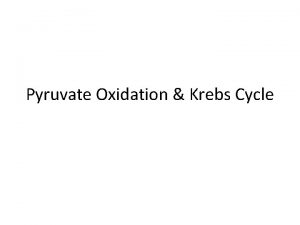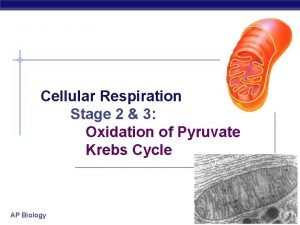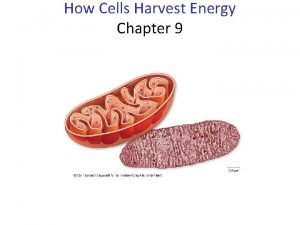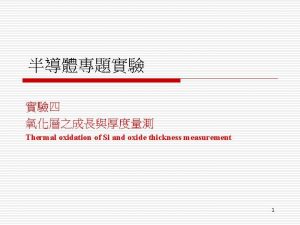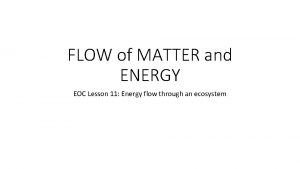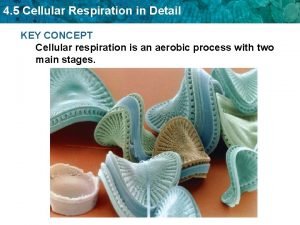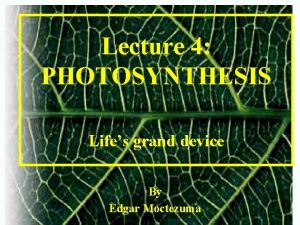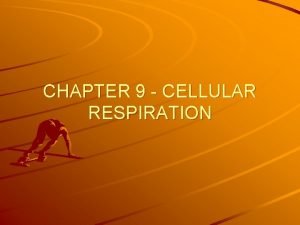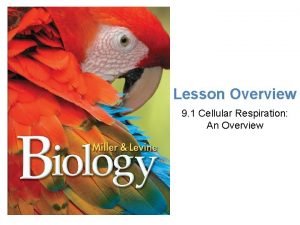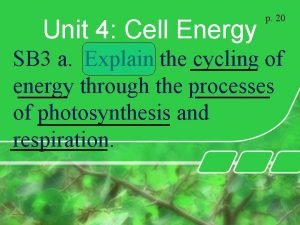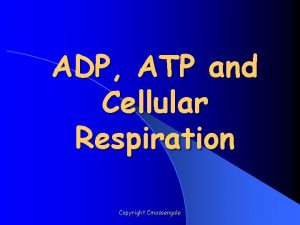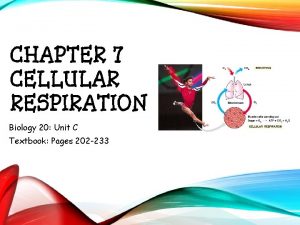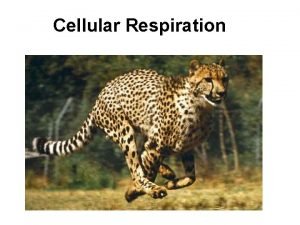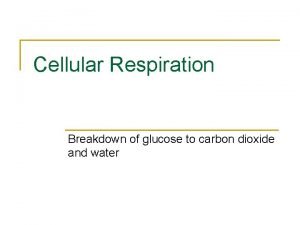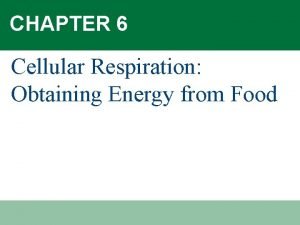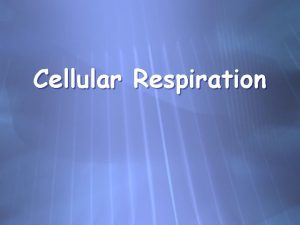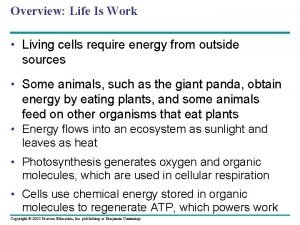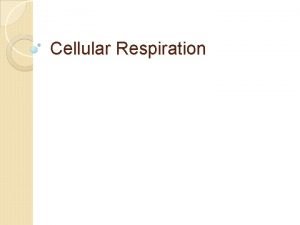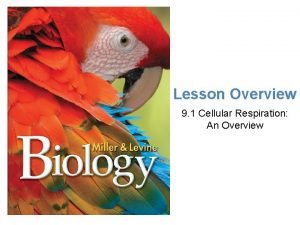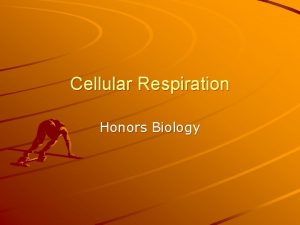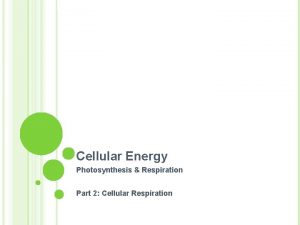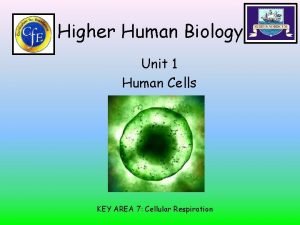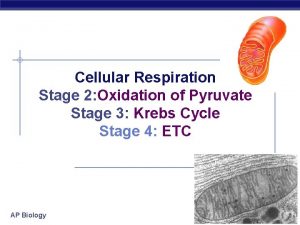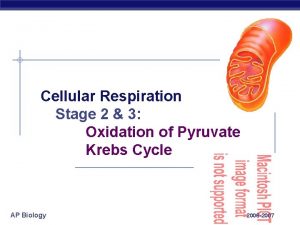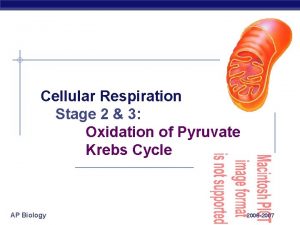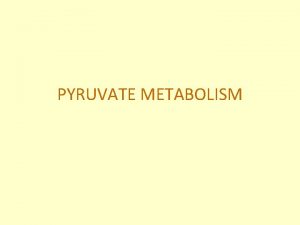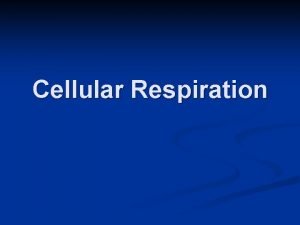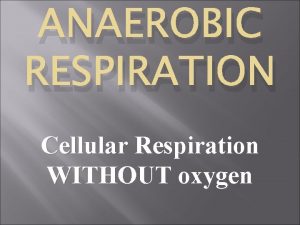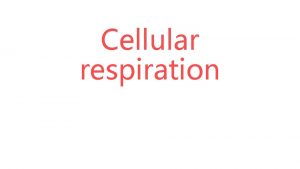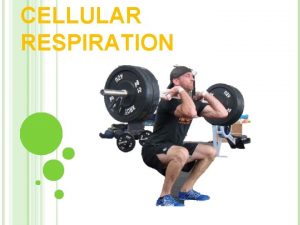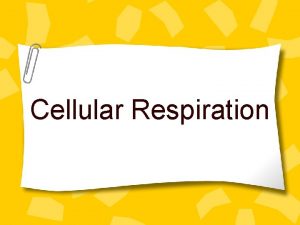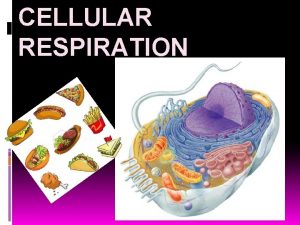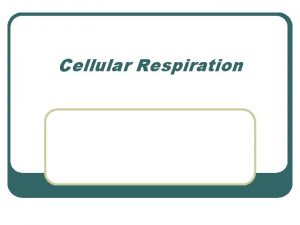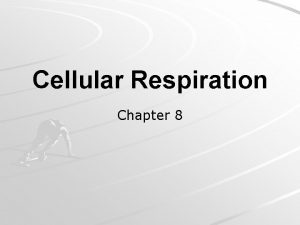Cellular Respiration Stage 2 3 Oxidation of Pyruvate



























- Slides: 27

Cellular Respiration Stage 2 & 3: Oxidation of Pyruvate Krebs Cycle AP Biology 2006 -2007

Glycolysis is only the start § Glycolysis glucose pyruvate 6 C 2 x 3 C § Pyruvate has more energy to yield u u u 3 more C to strip off (to oxidize) if O 2 is available, pyruvate enters mitochondria enzymes of Krebs cycle complete the full oxidation of sugar to CO 2 pyruvate CO 2 AP Biology 3 C 1 C

Cellular respiration AP Biology

Mitochondria — Structure § Double membrane energy harvesting organelle u u smooth outer membrane highly folded inner membrane § cristae u intermembrane space § fluid-filled space between membranes u matrix § inner fluid-filled space u u DNA, ribosomes enzymes What cells would have AP Biology a lot of mitochondria? outer intermembrane inner space membrane cristae matrix mitochondrial DNA

Mitochondria – Function Oooooh! Form fits function! Dividing mitochondria Membrane-bound proteins Who else divides like that? Enzymes & permeases What does this tell us about the evolution of eukaryotes? Endosymbiosis! AP Biology Advantage of highly folded inner membrane? More surface area for membranebound enzymes & permeases

Oxidation of pyruvate § Pyruvate enters mitochondria [ 2 x pyruvate acetyl Co. A + CO 2 3 C 2 C 1 C NAD Where does the CO 2 go? Exhale! 3 step oxidation process u releases 1 CO 2 (count the carbons!) u reduces 2 NADH (moves e-) u produces acetyl Co. A u § Acetyl Co. A enters Krebs cycle AP Biology ]

Pyruvate oxidized to Acetyl Co. A reduction NAD+ Pyruvate C-C-C [ CO 2 Coenzyme A oxidation Acetyl Co. A C-C 2 x Yield = 2 C sugar + NADH + CO 2 AP Biology ]

Krebs cycle 1937 | 1953 § aka Citric Acid Cycle in mitochondrial matrix u 8 step pathway u Hans Krebs § each catalyzed by specific enzyme 1900 -1981 § step-wise catabolism of 6 C citrate molecule § Evolved later than glycolysis u AP Biology does that make evolutionary sense? § bacteria 3. 5 billion years ago (glycolysis) § free O 2 2. 7 billion years ago (photosynthesis) § eukaryotes 1. 5 billion years ago (aerobic respiration = organelles mitochondria)

Count the carbons! pyruvate 3 C 2 C 6 C 4 C This happens twice for each glucose molecule AP Biology acetyl Co. A citrate x 2 4 C 6 C oxidation of sugars CO 2 5 C 4 C 4 C 4 C CO 2

Count the electron carriers! pyruvate 3 C FADH 2 AP Biology 6 C 4 C NADH This happens twice for each glucose molecule 2 C 4 C 4 C acetyl Co. A citrate x 2 NADH 6 C reduction of electron carriers 4 C ATP CO 2 4 C CO 2 NADH 5 C CO 2 NADH

Whassup? So we fully oxidized glucose C 6 H 12 O 6 CO 2 & ended up with 4 ATP! AP Biology What’s the point?

Electron Carriers = Hydrogen Carriers H+ § Krebs cycle produces large quantities of electron carriers NADH u FADH 2 u go to Electron Transport Chain u AP Biology What’s so important about electron carriers? H+ H+ H+ H+ ADP + Pi ATP H+

Energy accounting of Krebs cycle 4 NAD + 1 FAD 4 NADH + 1 FADH 2 2 x pyruvate CO 2 3 x 1 C 3 C 1 ADP 1 ATP Net gain = 2 ATP = 8 NADH + 2 FADH 2 AP Biology

Value of Krebs cycle? § If the yield is only 2 ATP then how was the Krebs cycle an adaptation? u value of NADH & FADH 2 § electron carriers & H carriers w reduced molecules move electrons w reduced molecules move H+ ions § to be used in the Electron Transport Chain like $$ in the bank AP Biology

H+ And how do we do that? H+ H+ § Set up a H+ gradient allow H+ to flow through ATP synthase u powers bonding of Pi to ADP u ADP + Pi ATP ADP + P ATP H+ AP Biology But… Have we done that yet?

NO! The final chapter to my story is next! Any Questions? AP Biology

Cellular Respiration Stage 4: Electron Transport Chain AP Biology 2006 -2007

Electron Transport Chain Building proton gradient! NADH NAD+ + H e p intermembrane space H+ H+ H e- + H+ C e– NADH H FADH 2 NAD+ NADH dehydrogenase inner mitochondrial membrane e– Q AP Biology H+ e– H FAD 2 H+ + 12 O 2 cytochrome bc complex H 2 O cytochrome c oxidase complex mitochondrial matrix What powers the proton (H+) pumps? …

Stripping H from Electron Carriers § NADH passes electrons to ETC u u H cleaved off NADH & FADH 2 electrons stripped from H atoms H+ (protons) electrons passed from one electron carrier to next in mitochondrial membrane (ETC) transport proteins in membrane pump H+ (protons) across inner membrane to intermembrane space H+ TA-DA!! Moving electrons do the work! H+ H+ H+ H H+ C e– NADH AP Biology H+ Q e– FADH 2 FAD NAD+ NADH dehydrogenase e– 1 2 H+ + cytochrome bc complex 2 O 2 H 2 O cytochrome c oxidase complex ADP + Pi ATP H+

But what “pulls” the electrons down the ETC? O 2 AP Biology electrons flow downhill to O 2 oxidative phosphorylation

Electrons flow downhill § Electrons move in steps from carrier to carrier downhill to O 2 each carrier more electronegative u controlled oxidation u controlled release of energy u make ATP instead of fire! AP Biology

“proton-motive” force We did it! § Set up a H+ § § H+ H+ gradient Allow the protons to flow through ATP synthase Synthesizes ATP ADP + Pi ATP Are we there yet? AP Biology H+ H+ H+ ADP + Pi ATP H+

Chemiosmosis § The diffusion of ions across a membrane u build up of proton gradient just so H+ could flow through ATP synthase enzyme to build ATP Chemiosmosis links the Electron Transport Chain to ATP synthesis So that’s the point! AP Biology

Pyruvate from cytoplasm Inner + mitochondrial H membrane H+ Intermembrane space Electron transport C system Q NADH Acetyl-Co. A 2. Electrons provide energy 1. Electrons are harvested to pump protons and carried to the transport across the system. membrane. - NADH Krebs cycle e- e FADH 2 e- 3. Oxygen joins with protons to form water. ATP Mitochondrial matrix AP Biology e- H 2 O 1 O 2 +2 2 H+ O 2 H+ CO 2 2 H+ 32 ATP 4. Protons diffuse back in down their concentration gradient, driving the synthesis of ATP. H+ ATP synthase

Cellular respiration 2 ATP AP Biology ~4 0 A + ~2 ATP + ~34 ATP TP

Summary of cellular respiration C 6 H 12 O 6 + 6 O 2 § § § § 6 CO 2 + 6 H 2 O + ~40 ATP Where did the glucose come from? Where did the O 2 come from? Where did the CO 2 go? Where did the H 2 O come from? Where did the ATP come from? What else is produced that is not listed in this equation? § Why do we breathe? AP Biology

Taking it beyond… § What is the final H+ H+ H+ C Q e– FADH 2 FAD electron acceptor in NADH 2 H + NAD Electron Transport O 2 Chain? So what happens if O 2 unavailable? § ETC backs up e– + + NADH dehydrogenase § cytochrome bc complex e– 1 2 O 2 H 2 O cytochrome c oxidase complex nothing to pull electrons down chain u NADH & FADH 2 can’t unload H u AP Biology § ATP production ceases § cells run out of energy § and you die!
 Oxidation of pyruvate
Oxidation of pyruvate Oxidation of pyruvate
Oxidation of pyruvate Pyruvate oxidation
Pyruvate oxidation Dry oxidation wet oxidation
Dry oxidation wet oxidation Cellular respiration steps
Cellular respiration steps Photosynthesis or cellular respiration
Photosynthesis or cellular respiration Concept 5 cellular respiration
Concept 5 cellular respiration Cellular respiration
Cellular respiration Cellular respiration releases
Cellular respiration releases Cellular respiration
Cellular respiration Concept map cellular respiration
Concept map cellular respiration Overview of cellular respiration
Overview of cellular respiration What is adp made of
What is adp made of Cellular respiration
Cellular respiration Cellular respiration in the mitochondria
Cellular respiration in the mitochondria Cellular respiration
Cellular respiration Coenzymes in cellular respiration
Coenzymes in cellular respiration Cellular respiration obtaining energy from food
Cellular respiration obtaining energy from food Where does cellular respiration take place
Where does cellular respiration take place Total atp produced in cellular respiration
Total atp produced in cellular respiration Cellular respiration formula
Cellular respiration formula Complimentary processes
Complimentary processes Calvin cycle
Calvin cycle Cellular respiration redox
Cellular respiration redox Cellular respiration organelle
Cellular respiration organelle What is the opposite of photosynthesis
What is the opposite of photosynthesis Higher human biology cellular respiration
Higher human biology cellular respiration Cellular respiration
Cellular respiration
